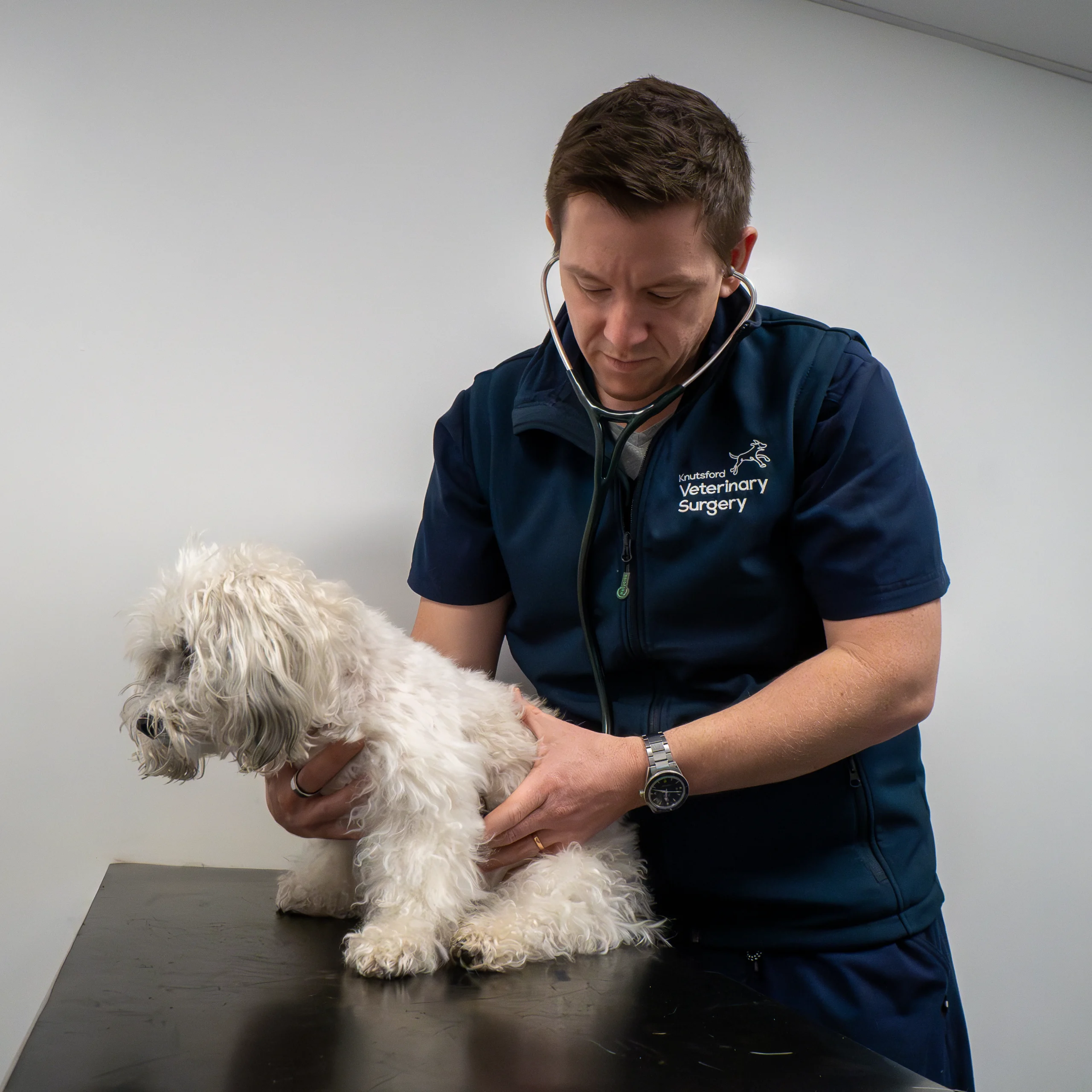Veterinary Dermatology.
Information on Small Animal Dermatology and Details for Veterinary Referrals.

About our Small Animal Dermatology Clinic
Cat or dog skin problems can be extremely troublesome for pets and owners alike. Constant itching or pawing can lead to infections, abrasions and serious discomfort.
Our small animal dermatology clinic is based in Knutsford, Cheshire, close to Stockport, Manchester, and Warrington. We provide honest, tailored care in a modern and relaxed environment. Our highly trained staff are on hand to support you and your pet throughout your journey. From initial consultation, through to diagnosis and treatment, we’re here for you.
What to Expect from Veterinary Dermatology
A referral to a veterinary dermatologist may seem daunting, especially if you’re increasingly concerned about your pet’s condition. However, with Knutsford Vets you can rest assured that you and your pet are in expert hands; we have additional training in small animal dermatology, and support staff that are here for you through the good and the bad.
We’ll first conduct an initial consultation and examination of your pet, including the evaluation of the skin, ears, feet, and mucous membranes. In most cases, we will then require some kind of cytology to help diagnose the problem. Samples may be collected as a skin scraping, impression smear, swab, or via fine needle aspiration/biopsy, depending on the condition. Histology may be used if cytology cannot make a definitive diagnosis.
We may then need to send samples off for analysis, before discussing our findings with you and proposing a suitable treatment plan and getting your pet back to good health. Learn more about diagnostic tests on our blog.
Specialist Equipment
At Knutsford Vet’s we’ve invested in high-tech specialist veterinary dermatology equipment to allow us to diagnose and treat a wide range of animal dermatology conditions. We also have a range of on-site testing equipment which allows us to provide you with answers to your pet’s skin concerns right here in the surgery, saving time and money.
What’s more, we’ve invested in a machine called Scopio, an all-in-one digital cytology tool that offers results within an hour, and is available 24/7. We use Scopio to bring you answers much faster than usual, allowing us to begin planning your pet’s treatment or next steps the very same day.
This means we’re the perfect vets to help manage your pets skin problems or help offer a vital second opinion at diagnosis.
Second Opinions & Veterinary Referrals
// Caring for Pets with Purpose //
For vets looking to refer a patient, fill out our veterinary referral form today.
Why Choose Us

Quick & Accurate

Specialist Equipment & Operating Theatre

Continuity Of Care

Advanced Training

Tailored Care And Treatments

Medication & Treatments
Common Causes of Itching in Pets
- Bacterial infection
- Fungal infection
- Mites, fleas, and other parasites
- Contact allergies
- Food allergies
Common Signs of Pet Skin Allergies
Regardless of the cause of the itch, once your pet starts scratching, they find it difficult to stop. Once the skin barrier is broken this leaves the potential for opportunistic bacteria and yeast to invade causing infections. In turn these infections will make the skin even itchier.
Some of the most common signs, other than itching, of an allergic skin reaction are: –
- Red skin – in general or just in certain areas
- Hair loss or short broken hair
- Spots – either red raised lumps (papules), pus filled lumps (pustules) or even blackheads (comedones).
- Crusting – this can occur as pustules rupture and scab on the skin or in rings of flaky skin associated with bacterial infections.
- Brown nails – this is often a sign of yeast infection of the nail beds which can occur in allergies due to foot chewing as yeast thrives in warm environments.
- Flaky skin – this can be a sign that the skin barrier is dry and therefore more likely to allow allergies to occur.
- Ears – the skin can become thick and red, discharge can develop – either pus (yellow/green) or yeast (brown).
- Over time if the skin inflammation continues the body protects itself by thickening the skin (lichenification) and by laying down extra pigment creating dark areas of skin (hyperpigmentation).
What to Do If Your Pet Has Sore or Itchy Skin
Small Animal Dermatology Diagnosis
One of the most challenging things about dermatology conditions is that, regardless of the cause, the signs that your pet shows are often the same. For this reason we often have to undertake a range of diagnostic tests to help differentiate the cause and also any secondary conditions present. Cytology (the microscopic study of cell samples collected from your pet’s body) and histology (the study of tissues) will often be used to try to determine the cause of the problem, with samples collected via skin scraping, impression smear, swab, or via fine needle aspiration/biopsy, depending on the condition.
The results from these tests will help us to make an accurate diagnosis, before preparing and presenting you with a tailored treatment plan to help get your pet back to good health.
Small Animal Dermatology Treatment
Whilst some skin conditions are treatable, it’s important to be aware that not all skin conditions have a cure, and instead, treatment is aimed at managing signs, such as reducing itching and preventing and reducing the occurrence of skin infections.
Depending on your pet’s condition and individual circumstances, your vet may recommend any of the following treatments:
- Antibacterial shampoos or creams to treat infection. In the worst cases of deep infections, antibiotics may be required
- Diet change – either as part of an elimination diet trial, or to improve the skin’s barrier
- Anti-itch medication
- Anti-inflammatory medication
- Topical treatments – such as ointments and shampoos
- Immunotherapy
- Surgery – for severe, specific conditions
